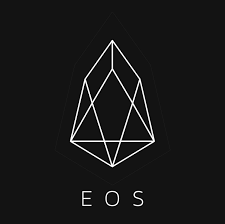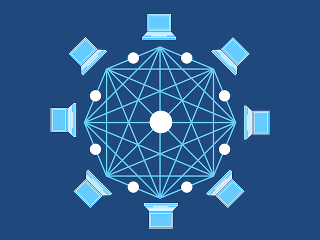
What is EOS?
EOSIO is software that introduces a blockchain architecture designed to enable vertical and horizontal scaling of decentralized applications. This is achieved through an operating system-like construct upon which applications can be built.
Block.one has developed the EOSIO Software and it is headed by Dan Larimer who has worked on other blockchain projects like Steemit and Bitshares.
EOSIO uses the Delegated Proof of Stake(DPOS) consensus mechanism, and additionally adds asynchronous Byzantine Fault Tolerance (aBFT) for faster achievement of irreversibility. The aBFT algorithm provides 100% confirmation of irreversibility within 1 second.
The software provides accounts, authentication, databases, asynchronous communication and the scheduling of applications across multiple CPU cores and/or clusters. The resulting technology is a blockchain architecture that has the potential to scale to millions of transactions per second, eliminates user fees and allows for quick and easy deployment of decentralized applications.
The EOSIO software enables blockchains to establish a peer-to-peer terms of service agreement or a binding contract among those users who sign it, referred to as a “constitution”. Check out the video below on Huobi Talk where 7 EOS block producers discuss blockchain governance and cryptonomics !
Additionally, you can register on Huobi to get EOS tokens using the current trading pairs — USDT, BTC, ETH and HT.
Consensus Mechanism

There are many different types of consensus mechanisms used in blockchain and the 3 common one are Proof of Work(PoW) , Proof of Stake (PoS) and Delegated Proof of Stake (DPoS) which has been popular with many new blockchain projects.
Lets take a look into these consensus mechanisms and compare them
Proof of Work (PoW)
requires miners to solve a mathematical puzzle, form the new block and confirm the transactions. When a miner finally finds the right solution, they announce it to the whole network and receives a reward provided by the protocol. This “mathematical puzzle” has a key feature — asymmetry. The work must be moderately hard for the miner but easy to check for the network.PoW ensures security as mining helps to verify the legitimacy of a transaction and hence help protect against double-spending.
Proof of Stake (PoS)
requires the miner to hold a large amount of the cryptocurrency.By staking the coins, the miner earns the right to validate transactions, forge blocks, and earn associated rewards. For example if Bob owns 2% of all of the coins of a POS blockchain , the probability of Bob mining a proof-of-stake block is 2%.Delegated Proof of Stake (DPoS)
involves users ‘voting’ to select ‘witnesses’ or delegates/block producers(other users they trust to validate transactions), and the top few delegates with the most votes earn the right to validate transactions. In EOS this number is 21 block producers. Additionally, users can even delegate their voting power to other users, whom they trust to vote for witnesses on their behalf. How much voting power a user has is proportional to the amount of tokens each user has.Is DPoS better?
In PoW, all the work done by every other miner that has not provided a solution in time is thrown away, wasting resources. DPoS is much faster due to a significantly smaller number of users verifying transactions and creating blocks. Therefore, DPoS is much more efficient and in turn more scalable.
Proof of Stake systems have the blockchain’s rules and parameters programmed into the genesis block. Consequently, any changes mean a fork in the protocol. Conversely, DPoS-based blockchains have an elected panel of delegates who actively govern the blockchain and can propose changes to the protocol, although such changes must be approved by the users for them to take effect.
Therefore, DPoS aims to create better incentives and a fast, scalable, more distributed and more efficient consensus mechanism.
Ram Trading in EOS

The EOSIO blockchain software allowed block producers to configure the amount of RAM (Random Access Memory) that their full nodes and the EOS system currently has 64GB of RAM available to the market. RAM is required to store account information such as keys, balances, and contract state.
Decentralized application (Dapp) developers face two costs when building their system.
The cost of interacting with the blockchain
The cost of hosting a full node
Keeping RAM scarce (64 GB) lowers the cost of hosting a full node, but
increases the cost of interacting with the blockchain.
Since RAM is scarce and that it can only be bought and sold (it cannot be transferred from user to user) , RAM price speculation started to take place and costed up to $4 per KB. This is determental to the EOS ecosystem as “expensive RAM makes a blockchain unviable for many business models” as quoted from Dan Larimer . What more is that these speculators are not actually using the RAM for their Dapps and hence this makes things much more frustrating for legitimate developers. This could lead developers to migrate to other blockchain solutions such as the time-tested Ethereum or the promising TRON network which is similar to EOS in terms of its cryptonomics.
How will EOS solve this?
Well , the network could clearly maintain significant decentralization while raising the cost of a full node by adding more RAM to make it less scarce. Based on calculations of the cost of RAM at current prices, an increase in on-chain RAM and more expensive full nodes would be cheaper for the users of the overall network. However, a finalized solution is yet to be drafted and it may take some time for everyone to agree on the best solution.
Conclusion
The block producers are working very closely together and with Block.one to come up with a solution that is beneficial to everyone in the EOS ecosystem. Expensive ram will hurt developers and the effect will probably be passed on to the users as well. Many ideas have been thrown around and I am certain that with many vested groups and individuals are working together to conceive a solution , these issues would be water under a bridge.
As we can see, blockchain governance is complex but perhaps it is necessary and we could say the same for the cryptonomics of blockchains such as them never being completely free or else malicious entities could abuse the system. Time will tell if blockchain solutions can truly be integrated into our digital economy.
Sources:
https://eos.io
https://medium.com/@bytemaster/eosio-ram-market-bancor-algorithm-b8e8d4e20c73
Follow me on :
https://www.twitter.com/corytam93
https://www.linkedin.com/in/corytam93/
https://medium.com/@corytam93
New to blockchain and cryptocurrencies? Use my crypto guide bot to learn and get started https://t.me/ccguidebot !
DISCLAIMER:
Cryptocurrency trading/investing involves substantial risk of loss and is not suitable for every investor. The prices of cryptocurrencies may fluctuate, and, as a result, you may lose more than your original investment.
If the market moves against you, you may sustain a total loss greater than the amount you deposited into your account. You are responsible for all the risks and financial resources you use. You should not engage in trading unless you fully understand the nature of the transactions you are entering into and the extent of your exposure to loss. If you do not fully understand these risks you must seek independent advice from your financial advisor.
All trading strategies are used at your own risk.
This is not financial advice and I do not advise you to buy any cryptocurrency based on my material or any interpretation of it.